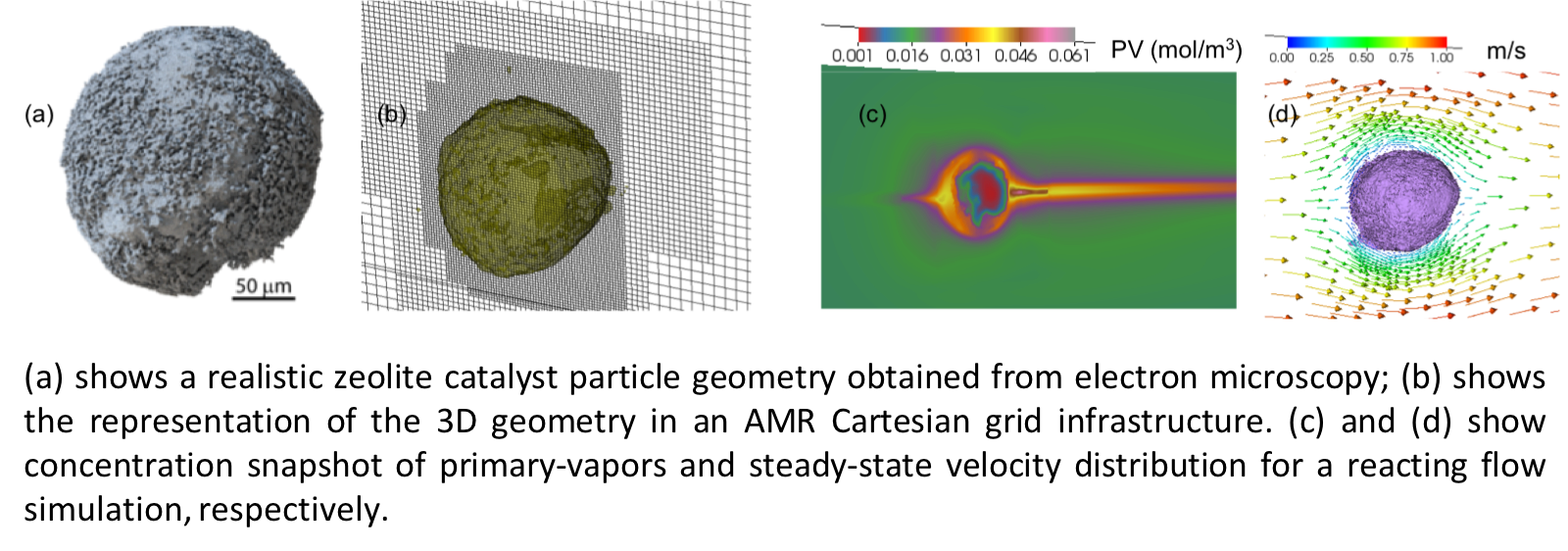(252d) An Adaptive-Mesh-Refinement Based Computational Tool for Simulating Catalysis at Mesoscale
AIChE Annual Meeting
2020
2020 Virtual AIChE Annual Meeting
Engineering Sciences and Fundamentals
Mesoscale Modeling Advances for Thermodynamics, Transport and Reaction
Tuesday, November 17, 2020 - 8:45am to 9:00am
In this work, we present a computational tool for mesoscale applications using open-source exascale-computing compatible adaptive-mesh-refinement (AMR) library, AMReX [2]. AMReX is software library that enables development of application solvers with block-structured Cartesian AMR. Our tool has capabilities to include realistic geometry representation, chemical species transport, reactions and thermodynamics that are critical for capturing mesoscale physics. A significant achievement is the ability of our solver to automatically import electron microscopy data in the form of a stereolithography (STL) or pixelated file formats (mrc, tiff) without undergoing the tedious task of unstructured mesh generation. This feature allows for rapid simulation of catalyst particles with complex morphologies using an immersed-boundary formulation. The use of AMR allows for higher resolutions at catalyst surface interfaces, which in turn provides an accurate description of surface reactions and transport. Our solver uses a hybrid distributed and shared memory parallelism (OpenMP/GPU-based) with which strong scaling up to 10,000 processors for realistic catalyst particle simulations have been demonstrated.
A mesoscale simulation of a realistic zeolite particle used for catalytic upgrading of biomass pyrloysis products is presented (see figure enclosed). We use a chemical mechanism that includes the reactant primary-vapors , various catalytic surface sites, coke and hydrocarbon products that has been validated against experiments. These simulations show how coking deactivates surface sites. The use of AMR allows for tracking morphology changes and porosity reduction due to coke formation. These high-fidelity mesoscale simulations will create a pathway in developing accurate particle-based models for macroscale simulations of larger reactors for catalytic upgrading.
[1] Ciesielski, P.N. et al. “Advancing catalytic fast pyrolysis through integrated multiscale modeling and experimentation: Challenges, progress, and perspectives.†Wiley Interdisciplinary Reviews: Energy and Environment, 7(4), p.e297.
[2] Zhang, Weiqun, et al. "AMReX: a framework for block-structured adaptive mesh refinement." Journal of Open Source Software 4.37 (2019)
Checkout
This paper has an Extended Abstract file available; you must purchase the conference proceedings to access it.
Do you already own this?
Log In for instructions on accessing this content.
Pricing
Individuals
| AIChE Pro Members | $150.00 |
| AIChE Emeritus Members | $105.00 |
| AIChE Graduate Student Members | Free |
| AIChE Undergraduate Student Members | Free |
| AIChE Explorer Members | $225.00 |
| Non-Members | $225.00 |
